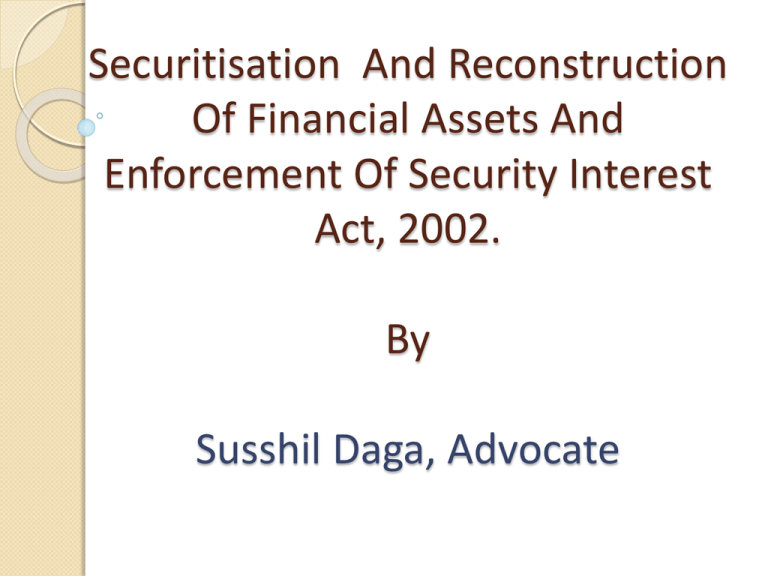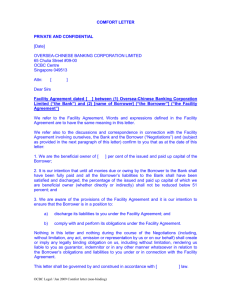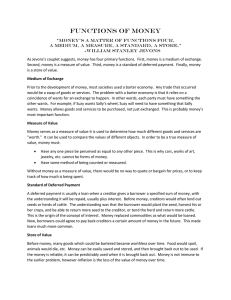Securtisation
advertisement

Securitisation And Reconstruction Of Financial Assets And Enforcement Of Security Interest Act, 2002. By Susshil Daga, Advocate PRIOR to SARFESI Prior to this Act a special legislation called ‘The Recovery of Debts due to Banks and Financial Institution Act, 1993’ was enacted creating a Special Tribunal called ‘Debt Recovery Tribunal’. Under the Act, the Banks are entitled to approach the Tribunal by filing an ‘Original Application’ which is similar to filing a suit in Civil Court proceedings. However, unlike the ‘Civil Court’ which is supposed to follow the ‘Civil Procedure Code’, a special and simple procedure was prescribed in RDBI, Act. Need for SARFESI The object of reducing ‘Non-performing Assets’ could not be achieved even after enacting ‘RDBI, Act1993’ and as a result, another legislation on the similar field was enacted and called ‘SARFAESI Act’. Many know as to what happens in Civil Courts and many know as to how to delay a Civil Case for so many years. . Under SARFAESI Act, 2002, the Bank can determine the outstanding due after noting the objections from the borrower/guarantor if any proceed against the ‘secured asset’ by taking physical possession of the same and initiating auction proceedings in accordance with the provisions and the SARFAESI rules. Object, Extent & Need An Act to regulate securitisation and reconstruction of the financial assets and enforcement of the security interest and matter connected therewith or incidental thereto. The acts extends to whole of India. It came into force on the 21st day of June 2002. Banks and FI’s lends money by obtaining security. The security is obtained to act as a protection for the money advanced and in case of need, the money can be realized by the sale of securities. Lender’s right over the securities, both moveable and immoveable, for the realization of the amount advanced, were limited and less effective since they were required to take help of the legal system which was taking unduly long time to complete prior to passing of the SARFESI Act,2002. Bird’s Eye View of SARFESI, 2002 Chapters Contents Section I II Preliminary 1-2 Regulation of Securitisation and Reconstruction 3-12A of Financial Assets of Banks and Financial Institution. III IV V Enforcement of Security Interest Central Registry Offenses And Penalty 13-19 20-26 27-30 VI Miscellaneous 31-42 Susshil Daga, Associate, Chir Amrit Law Chambers, Jaipur 5 Constitutional Validity of SARFESI, 2002 MARDIA CHEMICALS VS UNION OF INDIA (AIR 2004 SC 2371) Since these already existed a RDBI, Act1993. These was no need for draconian legislation like SARFESI. The mechanism provided for recovery of the debt under S.13 does not provide for any adjudicatory forum. NPA is declared on whims and fancies. That remedy of appeal under S.17 of the Act is also illusory since appeal is entertainable only when 75% of amount claimed, is deposited by the borrower. Important Aspects The two important aspects dealt in the Act are: ◦ Enforcement of Security Interest AND ◦ Securitisation and Reconstruction of Financial Assets of Banks and Financial Institution. Susshil Daga, Associate, Chir Amrit Law Chambers, Jaipur 7 PART I Enforcement of Security Interests Susshil Daga, Associate, Chir Amrit Law Chambers, Jaipur 8 SECURITIZATION Securitisation means acquisition of financial assets by any securitization company or reconstruction company. from any originator, whether by raising funds by securitization co. through QIB’s by issue of security receipts representing, undivided interest in such financial asset or otherwise. Securing Assets Lender/Orginator Borrower/Obligor Financial Assistance Considerat ion of asset purchased Transfer of Secured Assets Security Receipt QIB/ Investor SPV Subscription of securities 9 TAKING THE ASSET FOR SECURITIZATION Sec. 6(1) When the bank or financial institution decides that the financial asset be now acquired by the securitization company or reconstruction company a notice may be given about such acquisition to the obligor i.e. borrower or any other person liable to repay to the bank. Susshil Daga, Associate, Chir Amrit Law Chambers, Jaipur 10 NOTICE FOR ENFORCEMENT OF SECURITY Section 13(2) of the SARFAESI Act speaks about the notice to be given by the secured creditor to the borrower who has defaulted in making the repayment and whose account is classified as NPA. Susshil Daga, Associate, Chir Amrit Law Chambers, Jaipur 11 NOTICE FOR ENFORCEMENT OF SECURITY Sec. 13(2) The precondition to get the right to serve this notice is that the notice should be asking the borrower to discharge in full his liabilities to the secured creditors within sixty days from the date of notice. Failing to pay so by the borrower the secured creditor gets further rights as detailed in the Act. Susshil Daga, Associate, Chir Amrit Law Chambers, Jaipur 12 NOTICE FOR ENFORCEMENT OF SECURITY Sec. 13(2) The notice should give the details of the amount payable by the borrower and the secured asset intended to be enforced by the secured creditor in the event of nonpayment of secured debt by the borrower Susshil Daga, Associate, Chir Amrit Law Chambers, Jaipur 13 NOTICE FOR ENFORCEMENT OF SECURITY Though the Act contemplates giving of only two particulars, viz. details of amount payable and details of securities, in the notice said above, it is more proper to give the details of defaults, overdue period and the date from which the account is classified as NPA, facility-wise securities and particulars of security documents executed by the borrower Susshil Daga, Associate, Chir Amrit Law Chambers, Jaipur 14 NOTICE FOR ENFORCEMENT OF SECURITY Any contravention of these legal consequences if made by the borrower is punishable under the SARFESI Act. So it is advisable that the notice mentions about the legal consequences and penal provisions. Susshil Daga, Associate, Chir Amrit Law Chambers, Jaipur 15 NOTICE FOR ENFORCEMENT OF SECURITY The Act does not contemplate a reply from the borrower to the notice. But the borrower may make representation to the notice so received by him Susshil Daga, Associate, Chir Amrit Law Chambers, Jaipur 16 NOTICE FOR ENFORCEMENT OF SECURITY If the borrower submits any representation to the said notice, the Bank is required to give reply to that notice under Section 13(3A) within a week Susshil Daga, Associate, Chir Amrit Law Chambers, Jaipur 17 NOTICE FOR ENFORCEMENT OF SECURITY The secured creditor must apply his mind to the objection raised by the borrower in reply to the notice served on him by the secured creditor and reasons for rejection must be conveyed to the borrower Susshil Daga, Associate, Chir Amrit Law Chambers, Jaipur 18 NOTICE FOR ENFORCEMENT OF SECURITY The reply to the borrower giving the reasons for not accepting the objections of the borrower does not give an occasion to resort to any proceedings, such as stay application, injunction etc. to restrain creditor’s actions Susshil Daga, Associate, Chir Amrit Law Chambers, Jaipur 19 BORROWER NOT PAYING AS PER NOTICE Bank can take possession of the secured assets of the borrower including right to transfer by way of lease, assignment or sale for realising the secured asset Take over the management of the secured asset of the borrower including the right to transfer by way of lease, assignment or sale and realize the secured asset. Appoint any person as manager to manage the security assets the possession of which has been taken over by the secured creditor. Require at any time, by giving notice in writing, any person who has acquired the secured asset from the borrower and from whom any money is due or may become due to the borrower, to pay to the secured creditor. Such demands from the other person will be to the extent of secured debt. Susshil Daga, Associate, Chir Amrit Law Chambers, Jaipur 20 BORROWER NOT PAYING AS PER NOTICE Appoint any person as manager to manage the security assets the possession of which has been taken over by the secured creditor. Require at any time, by giving notice in writing, any person who has acquired the secured asset from the borrower and from whom any money is due or may become due to the borrower, to pay to the secured creditor. Such demands from the other person will be to the extent of secured debt. Susshil Daga, Associate, Chir Amrit Law Chambers, Jaipur 21 HOW TO APPROPRIATE SALE PROCEEDS When sale of secured asset is made the appropriation of sale proceeds realized are required to be made in the following order, Firstly, towards costs, charges and expenses incidental towards preservation and protection of securities, insurance premiums etc. that are recoverable from the borrower. Secondly, towards the due of the secured creditors. Thirdly, if there is any surplus it will be paid to the person entitled there to in accordance with the right and interests. Susshil Daga, Associate, Chir Amrit Law Chambers, Jaipur 22 RULES OF NATURAL JUSTICE In Mahesh Chandra vs. UP Finance Corporation 78 Comp Cas 1, SC set important rules of natural justice in repossession. The technicalities implied by these rules have been overruled by the SC in Jagadamba Oil Mills case but the rules of natural justice continue to apply. The following are implicitly still applicable: ◦ Attempt must be made for best possible price - easiest indication is a public auction. ◦ Borrower must always be given a right of first refusal or improving upon the price ◦ The sale must not be made at the back of the borrower Susshil Daga, Associate, Chir Amrit Law Chambers, Jaipur 23 Who should exercise powers from Bank The SARFAESI Act has given different rights to the secured creditor. The rights of a secured creditor under the Act need be exercised by one or more of its officers authorized in this behalf in such manner as may be prescribed. The powers of enforcing securities need to be exercised prudently, fairly and with due care and caution the Rules framed under SARFESI Act Susshil Daga, Associate, Chir Amrit Law Chambers, Jaipur 24 Restrictions on borrower on receiving u/s. 13(2) notice When the borrower receives the notice from the creditor under section 13(2) the borrower shall not transfer by way of sale, lease or otherwise, other than in the ordinary course of business, any of his secured assets referred to in the notice without prior written consent of the secured creditor. Non compliance with this provision attracts penal provisions under SARFAESI Act that provide punishment of imprisonment of one year or fine or both. Susshil Daga, Associate, Chir Amrit Law Chambers, Jaipur 25 Judicial Authority’s help to Bank for taking possession When the secured creditor is required to take possession or control of the secured asset or when the secured asset is required to be sold or transferred under the provisions of the SARFAESI Act, the secured creditor can take help of the Chief Metropolitan Magistrate or the District Magistrate by making request in writing. On such request being made the Chief Metropolitan Magistrate or the District Magistrate, as the case may be, shall take possession of security asset and documents relating thereto. The Metropolitan Magistrate or the District Magistrate may take or cause to be taken such steps and use or cause to be used such force as may be in his opinion necessary. Any act of the Metropolitan Magistrate or the District Magistrate for and while taking possession of the security shall not be called in question in any court or before any authority. Susshil Daga, Associate, Chir Amrit Law Chambers, Jaipur 26 Notice on taking Management of the borrower concern When the secured creditor takes over the management of business of a borrower, he may publish a notice in a news paper published in English language and in a news paper published in Indian language in circulation in the place where the principal office of the borrower is situated, for appointment of, Director -if the borrower is a company as defined in the companies Act, 1956, to be the directors of such company or Administrator -in any other case, to be the administrator of the business of borrower. Susshil Daga, Associate, Chir Amrit Law Chambers, Jaipur 27 Effect of notice and taking over the management On publication of such notice, the directors of the company in case the borrower is a company and in other cases person holding any office having power of superintendence, direction and control of the business of the borrower immediately before publication of the notice, shall be deemed to have vacated their offices. As effect of this, any contract or management between the borrower and any directors or manager thereof shall be deemed to be terminated. On publication of the above said notice and then after the appointments of directors or the administrators as stated above, all the property and effects of the business of borrower is deemed to be in the custody of the directors or the administrators so appointed, as the case may be. Susshil Daga, Associate, Chir Amrit Law Chambers, Jaipur 28 Effect of notice and taking over the management All the directors or the administrators are empowered to take such steps as may be necessary to take into their custody or under their control all the property, effects and actionable claims to which the borrower is entitled. Thereafter, the directors or the administrators are alone entitled to exercise all the powers of superintendence, direction and control of the business of the borrower. Such powers are derived as if from the memorandum or articles of association of the company or from any other source whatsoever. Susshil Daga, Associate, Chir Amrit Law Chambers, Jaipur 29 Effect of notice and taking over the management Where the management of the business of a borrower which is a company as defined in the Companies Act, 1956 is taken over by the secured creditor, then, notwithstanding anything contained in the Companies Act 1956 or the memorandum or in the articles of association following effects apply; The shareholders of the company can lawfully appoint any person to be a director of the company. No resolution passed by the shareholders of the company shall be given effect to unless approved by the secured creditor. No proceeding for the winding up of such company or for the appointment of a receiver for the company shall lie in any court, except with the consent of the secured creditor. Susshil Daga, Associate, Chir Amrit Law Chambers, Jaipur 30 Effect of notice and taking over the management No managing director or director or any person in charge of management of the business of the borrower shall be entitled to any compensation for the loss of office or for premature termination of any contract of management entered into by him with the borrower. This provision has a overriding effect over any other laws or contract. However, if any director or any other person controlling the management has to recover any amount from borrower, it can be recovered. Where the management of the business of a borrower has been taken over by the secured creditor, on realization of the debt in full the secured creditor shall restore the management of the business of the borrower to him. Susshil Daga, Associate, Chir Amrit Law Chambers, Jaipur 31 Challenging before DRT Bank’s action to take possession (APPEAL) Any person, including borrower, aggrieved by any of the measures taken by the secured creditor or his authorized officer for taking possession of the security may make an application along with the prescribed fees to the Debts Recovery Tribunal having jurisdiction within forty five days from the date on which such measure are taken. The Debts Recovery Tribunal has to dispose of the application, as far as may be, in accordance with the provisions of the recovery of Debts Due to Banks and Financial Institutions Act, 1993 and rules made there under. The application has to be disposed as early as possible but within sixty days. Susshil Daga, Associate, Chir Amrit Law Chambers, Jaipur 32 Challenging before DRT Bank’s action to take possession (APPEAL) If for any reason it is not possible to so dispose the application, the Tribunal has to record the reasons for delay but such delay should not be beyond four months from the date of filing of the application. If any such application is not disposed so within four months, the aggrieved party can prefer an application to the Appellate Tribunal for seeking directions for the early disposal of the application. Susshil Daga, Associate, Chir Amrit Law Chambers, Jaipur 33 Appeal to Appellate DRT Any person aggrieved by any order made by the Debts Recovery Tribunal can prefer appeal along with the prescribed fees to the appellate Tribunal within thirty days from the date of receipt of the order of Debts Recovery Tribunal. No appeal can lie unless the borrower deposits 50% of the debt claimed by the secured creditor. The Tribunal has powers for reasons to be recorded to reduce this amount to 25% of the claim amount Susshil Daga, Associate, Chir Amrit Law Chambers, Jaipur 34 PROTECTION OF ACTION TAKEN IN GOOD FAITH The secured creditors and their officers are protected by the provisions made in the Act for actions taken in good faith. For initiating actions by the secured creditor under the Act no suit, prosecution or any other legal proceeding can be taken against the secured creditor or his officers. This protection is given so that actions contemplated and authorized under SARFAESI Act can be taken without fear of counter action from the borrower or any other person having interest in the property. Susshil Daga, Associate, Chir Amrit Law Chambers, Jaipur 35 CIVIL COURTS NO JURISDICTION The SARFAESI Act has conferred jurisdiction on many matters to the Debts Recovery Tribunal or the Appellate Tribunal. Therefore, for any such matters where empowerment and jurisdiction is to the Debts Recovery Tribunal or the Appellate Tribunal, no Civil Court shall have jurisdiction to entertain any suit or proceeding. Similarly, any Court or Authority cannot grant injunction in such matters and actions taken or to be taken under this Act as well as under Recovery of Debts Due to Banks and Financial Institutions Act, 1993. Due to such provisions the implementation of the Act becomes effective. Susshil Daga, Associate, Chir Amrit Law Chambers, Jaipur 36 LIMITATION ACT -APPLICABLE The actions the secured creditor can take against the security the SARFAESI Act are required to be taken within the limitation as per section 36 of the Limitation Act. That means the action has to be taken within three years from the date on which cause of action arose Susshil Daga, Associate, Chir Amrit Law Chambers, Jaipur 37 DUES AFTER THE SARFAESI ACTIONS If after sale of securities the claim is not fully satisfied and still there are any dues to be recovered from the borrower, the creditor is required to file civil suit before the Civil Court or a claim before the Debt Recovery Tribunal or the Authorities / Courts under the Co-operative Societies Act, as may be applicable within limitation period. Therefore, the secured creditor will have to make an assessment, before taking possession of the security, whether it would be possible to sell the security and make eventual claim for shortfall within the limitation period. Susshil Daga, Associate, Chir Amrit Law Chambers, Jaipur 38 Exceptions under sec. 31 The provision of act shall not apply to Lien on goods, money or security under Contracts law or Sale of Goods Act: Pledge of movable within meaning of 172 of Indian contract act creation of security in any aircraft creation of security in vessels conditional sale, hire purchase or lease or any other contract in which no security interest has been created rights of unpaid seller properties not liable for attachment under CPC: where financial assistance not exceeding Rs 1 lac where dues are less than 20% of principal and interest agricultural land Susshil Daga, Associate, Chir Amrit Law Chambers, Jaipur 39 When Borrower Succeeds in Section 17 Again, even if borrower succeeds in his Appeal under section 17 of the SARFAESI Act, 2002, the borrower may not be happy. It is interesting. Because, the borrower might have clearly alleged or established that the Bank was at fault in adhering to the terms and conditions of the sanction and might have wanted the DRT to force the Bank to act upon the agreed terms. But, it will not happen and the DRT may simply set-aside the possession notice issued by the Bank under section 13 (4) of the Act and the Bank impliedly have an opportunity to start the proceedings afresh. It would be interesting to understand as to what that means. That may be mean nothing at times unless the borrower is interested only in getting some time to repay the outstanding amount. It is felt that the Debt Recovery Tribunal can grant no relief to the borrowers under section 17 except asking the Bank to start the proceedings afresh Susshil Daga, Associate, Chir Amrit Law Chambers, Jaipur 40 Alternate Remedy Central Bank of India vs. State of Kerala 2009 (4) SCC 94 That the right to property can be taken away only as per law and right to hold the property has been glorified as "Human Right". That apart, it is well settled law that availability of an alternative remedy is not an absolute bar for exercising the writ jurisdiction and it is only a selfimposed restraint on its power. there can not be any complications and there should effective remedy available to the aggrieved if there is merit in the contention and I do strongly feel that the High Court is required to entertain Writ Petitions even in respect of “SARFAESI Act” if required and in exceptional cases. We know that there can be people to approach the High Court with ulterior motives and such cases can easily be dealtwith. But, there should be effective remedy to the innocent owners and the innocent owners should not get troubled with the irregularities committed by the Bank or committed by individuals with the involvement of Bank either directly or indirectly. Right to property” is not a Fundamental Right and High Court should not entertain Writ Petitions in respect of cases under SARFAESI Act, 2002 though caution is to be exercised. Susshil Daga, Associate, Chir Amrit Law Chambers, Jaipur 41 Is it correct to say that "once NPA is always NPA" under SARFAESI Act, 2002? M/s. Sravan Dall Mill P. Limited, Rep. by its Managing Director Vs. Central Bank of India. “The right of the borrower to have a due consideration of objections is, therefore, an important right of the borrower where the bank is bound to apply its mind and inform the borrower of its reasons as to why and how the account is classified as NPA, particularly, when the borrower raises specific objections in that regard. The reply of the bank must indicate application of mind by the bank that the decision of the bank in classifying the account as NPA was fully in conformity with the prudential norms of RBI. Non-consideration of the said objection by mere statements in the reply that the bank has considered the same cannot be said to be the fulfilment of the obligation of the bank under Sections 13(2) and 13(3)(A) of the SARFAESI Act. It also cannot be disputed that even assuming that particular account had become NPA, the subsequent payments by the borrower entitles a borrower to upgrade the said account and may come out of the said classification of his account as NPA. Therefore, it is incorrect to presume that once an NPA is always an NPA and it is precisely for the said reason that the clause 4.2.4 of the prudential norms specifically states that if interest and principal are paid by the borrower in case of loans classified as NPA, the said account should no longer be treated as NPA and may be classified as sub-standard account. Consequently, therefore, the action under the SARFAESI Act with regard to the said account would not be tenable, as jurisdictional fact under Section 13(2) of the SARFAESI Act would remain unsatisfied”. Susshil Daga, Associate, Chir Amrit Law Chambers, Jaipur 42 PART II Securitisation and Reconstruction of Financial Assets of Banks and Financial Institution. Susshil Daga, Associate, Chir Amrit Law Chambers, Jaipur 43 Application to Banks All the Banking Companies, Nationalized Banks, the State Bank of India as well as its subsidiary Banks and Co-operative Banks are within the meaning of the word bank for the purpose of this Act "FINANCIAL INSTITUTION" means-- (i) a public financial institution within the meaning of section 4A of the Companies Act, 1956 (ii) any institution specified by the Central Government under sub-clause (ii) of clause (h) of section 2 of the Recovery of Debts Due to Banks and Financial Institutions Act, 1993. (iii) the International Finance Corporation established under the International Finance Corporation (Status, Immunities and Privileges) Act, 1958 (iv) any other institution or non-banking financial company as defined in clause (f) of section 45-I of the Reserve Bank of India Act, 1934, which the Central Government may, by notification, specify as financial institution for the purposes of this Act; Susshil Daga, Associate, Chir Amrit Law Chambers, Jaipur 44 ASSET RECONSTRUCTION Acquisition of any right or interest, in the security, by any securitization company or reconstruction company for the purpose of realization of such financial assistance is called as asset reconstruction Susshil Daga, Associate, Chir Amrit Law Chambers, Jaipur 45 SECURITIZATION Securitization means acquisition of financial asset by securitization or reconstruction company from the Bank for realization of debt. It is also called asset reconstruction It also includes change or take over of the management of the business of the borrower for proper management of business of the borrower Susshil Daga, Associate, Chir Amrit Law Chambers, Jaipur 46 BORROWER The borrower means, any person who has been granted financial assistance by any bank or who has given any guarantee or who has created any mortgage, hypothecation or pledge as security for the financial assistance granted by any bank or a person who becomes borrower of a securitization company or reconstruction company consequent upon acquisition by it of any right or interest of any bank or financial institution in relation to such financial assistance Susshil Daga, Associate, Chir Amrit Law Chambers, Jaipur 47 FINANCIAL ASSET a claim to any debt or receivables or part thereof whether secured or unsecured or any debt or receivable secured by mortgage of immovable property or hypothecation or pledge of movable property or any right or interest in the security, whether full or part, securing debt or any beneficial interest in any movable or immovable property or in debt, receivables, whether such interest is existing, future, accruing, conditional or contingent or any financial assistance Susshil Daga, Associate, Chir Amrit Law Chambers, Jaipur 48 NON PERFORMING ASSET An asset or account of a borrower classified by a bank as sub-standard, doubtful or loss-asset in accordance with the directions or under guidelines relating to asset classification issued by the Reserve Bank of India Susshil Daga, Associate, Chir Amrit Law Chambers, Jaipur 49 PROPERTY Property means, immovable property, movable property, any debt or any right to receive payment of money whether secured or unsecured, receivables, whether existing or future, intangible assets such as known-how, patent, copyright, trade mark, license, franchise or any other business or commercial right of similar nature. Susshil Daga, Associate, Chir Amrit Law Chambers, Jaipur 50 SECURED ASSET Secured Asset means the property on which security interest is created. The powers given by SARFAESI Act for enforcement of securities are against secured assets only Susshil Daga, Associate, Chir Amrit Law Chambers, Jaipur 51 SECURED CREDITOR and SECURED DEBT Any bank or any consortium or group of banks in whose favour security interest is created by the borrower for due repayment is called as secured creditor. Secured debt means a debt which is secured by any security interest Susshil Daga, Associate, Chir Amrit Law Chambers, Jaipur 52 SECURITY INTEREST Any right, title and interest of any kind whatsoever upon the property created in favour of any secured creditor is called as security interest Susshil Daga, Associate, Chir Amrit Law Chambers, Jaipur 53 Qualified Institutional Buyers "Qualified Institutional Buyer" means a financial institution, Insurance company, bank, state financial corporation, state industrial development securitisation company or reconstruction company which has been granted a certificate of registration under sub-section (4) of section 3 or any asset management company making investment on behalf of mutual fund or pension fund or a foreign institutional investor registered under the Securities and Exchange Board of India Act, 1992 (15 of 1992) or regulations made thereunder, or any other body corporate as may be specified by the Board; Susshil Daga, Associate, Chir Amrit Law Chambers, Jaipur 54 Thank you PROCESS Susshil Daga, Associate, Chir Amrit Law Chambers, Jaipur 56






